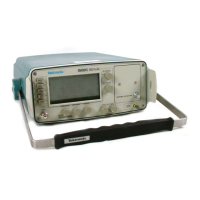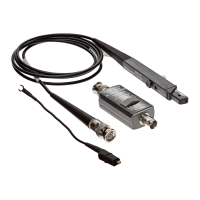Appendix D: Application Note
D–2
1502C MTDR User Manual
Relationships
Z
O
= (138 / pκ
)*
(log
10
D / d) for coaxial cable
%= r
*
100
VSWR = (1 + r) + (1 – r) for the case where VSWR is the same for all
frequencies
c = 30 cm / nanosecond = 0.984 ft / ns
V
F
= 1 / pκ
V
P
= 30 / pκ cm / ns = 0.984 / pκ ft /ns
C = 7.36 κ + (log
10
D / d)
L = 140 log
10
D / d
1 in = 2.54 cm
1 ft = 30.48 cm
1 m = 3.28 ft
VSWR vs. Percent Reflected Voltage
To find the Voltage Standing Wave Ratio (VSWR), knowing the percent reflected
voltage (%), or vice versa, use the Frequency Domain Conversions section of the
slide rule (see Figure D–1).
0 2 4 6 8 1012141618 20 %
1.00 1.05 1.10 1.15 1.20 1.25 1.30 1.35 1.40 1.45 1.50 VWSR
80 75 70 65 60 55 50 45 40 35 30 25 20 15 10 5 0
.01 .02.03 .05 .10 .2 .3 .5 .7 1.0 2 3 5 7 10 20 50 100 %30
SINGLE
RESISTIVE
DISCONTINUITY
ONLY
RETURN LOSS
(IMPULSE ONLY)
1.04 VSWR = 2% REFLECTION 20% = 1.5 VSWR
Figure D–1: Slide Rule of VSWR vs. Percent Reflected Voltage
On the upper scale, locate the known value of VSWR (or %). Adjacent to that
point is the corresponding value for % (or VSWR). VSWR is the peak-to-valley
ratio of standing sine waves.

